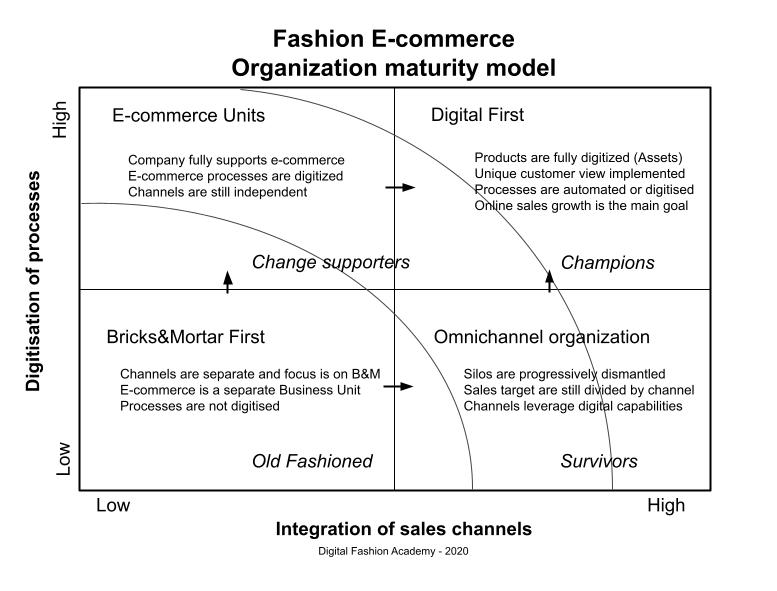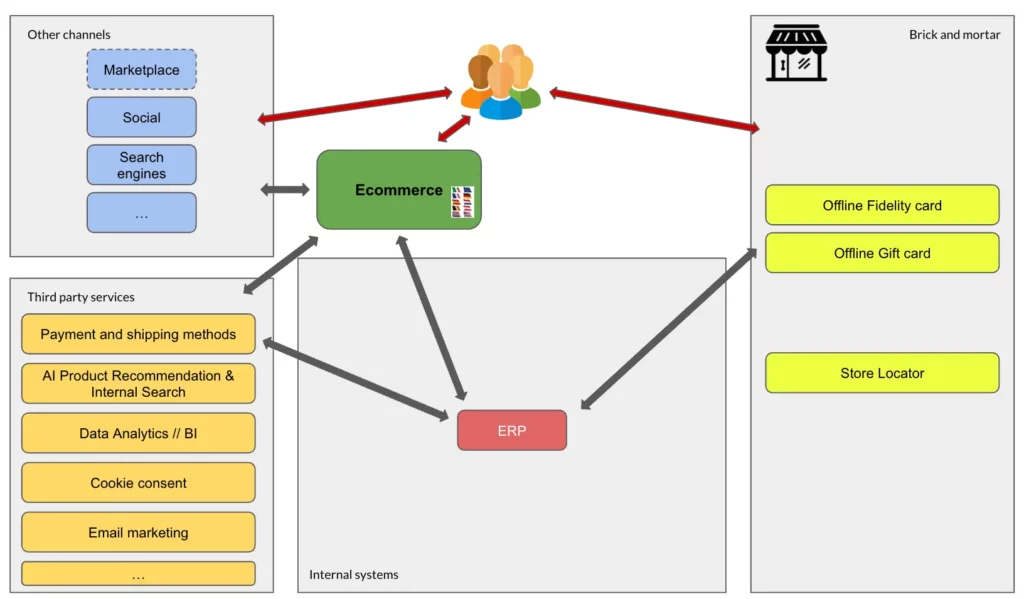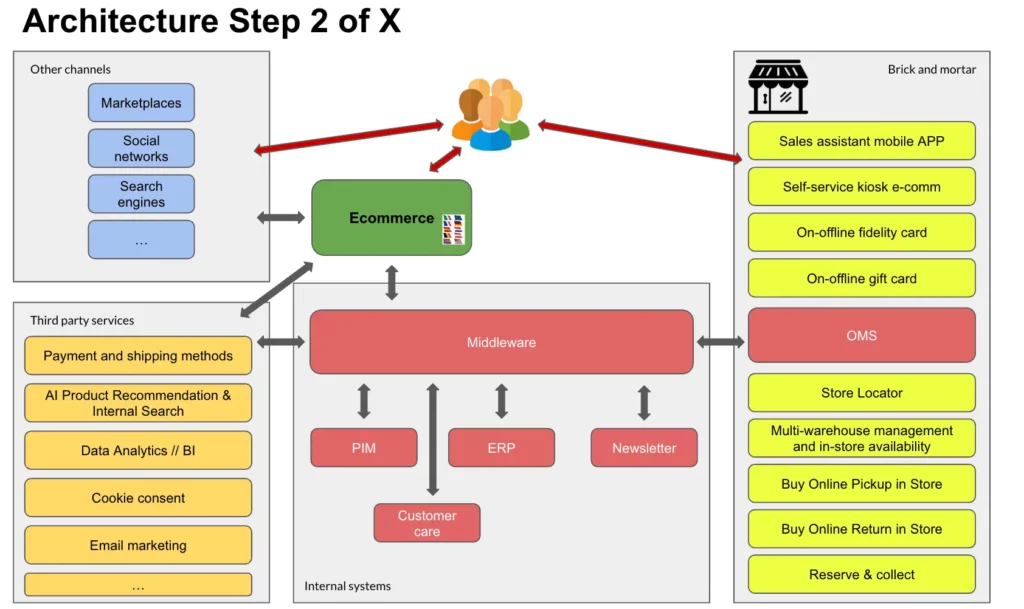Digitale Transformation in der Modebranche
Die digitale Transformation steht bei Modeunternehmen schon seit einigen Jahren auf der Agenda, doch selbst die großen Akteure mit immensen finanziellen Ressourcen tun sich mit diesem Transformationsprozess schwer.

- Digitale Transformation in der Modebranche
- Die größten Herausforderungen für Modeunternehmen im Umgang mit der digitalen Transformation:
- Was sind die Vorteile und Risiken der digitalen Transformation?
- Vorteile:
- Risiken
- Wie geht man mit den Risiken der digitalen Transformation um?
- Was sind die Enabler für die digitale Transformation in Modeunternehmen?
- So implementieren Sie die digitale Transformation in der Modebranche:
- So implementieren Sie effektive Schulungsprogramme für Mitarbeiter in der Modebranche
- Beispiel für die Architektur von Informationssystemen: Ist-Zustand und Soll-Zustand
- Beschleunigung und Verlangsamung der digitalen Transformation
- Die nächsten Schritte der digitalen Transformation in der Modebranche
- Die digitale Transformationsbewertung Ihres Unternehmens
Die größten Herausforderungen für Modeunternehmen im Umgang mit der digitalen Transformation:
- Das Topmanagement ist nicht im Bereich Digital Management geschult
- Entscheidungen basieren noch nicht ausreichend auf Daten.
- Bedarf an Investitionen in Technologie
- Notwendigkeit der Strukturierung der Organisation und Prozesse
Was sind die Vorteile und Risiken der digitalen Transformation?
Vorteile:
- Effizienter: Dies bedeutet, Geld zu sparen und die Margen sowohl bei der Beschaffung von Produkten als auch bei den Betriebskosten zu erhöhen, was wiederum zu einer Erhöhung des EBITDA führt
- Verbesserte Qualität der Entscheidungen: Entscheidungen werden auf der Grundlage genauerer und aktuellerer Daten bzw. Echtzeitdaten getroffen.
- Optimierte Prozesse: Bei der digitalen Transformation müssen die Prozesse Schritt für Schritt klar definiert werden.
Risiken
- Notwendigkeit einer Umschulung des oberen Managements: Mitarbeiter mit einer altmodischen Mentalität können sich möglicherweise nicht leicht anpassen
- Notwendigkeit der Veränderung: Die Umsetzung eines Transformationsprozesses erfordert eine Veränderung der Arbeitsgewohnheiten
- Widerstand der Mitarbeiter: Personen, die mehrere Jahre lang mit der gleichen Methodik gearbeitet haben, könnten sich der Veränderung widersetzen und den digitalen Transformationsprozess gefährden
Wie geht man mit den Risiken der digitalen Transformation um?
Um die Einführung digitaler Best Practices zu fördern, ist es notwendig, eine inkrementeller Ansatz, mit dem Ziel, die Organisation durch einen Reifegradzuwachs bei digitalen Fähigkeiten zu führen. Das Unternehmenswachstum kann durch Schulungen und Coaching der an der Transformation beteiligten Personen erreicht werden.

Was sind die Enabler für die digitale Transformation in Modeunternehmen?
Um einen digitalen Transformationsprozess zu starten, sind einige Voraussetzungen notwendig, wie zum Beispiel
- Verfügbarkeit digitaler Fachkräfte,
- ein Managementteam, das motiviert ist, die Organisation zu verändern
- Budget für Investitionen in IT-Lösungen, insbesondere Cloud und KI
So implementieren Sie die digitale Transformation in der Modebranche:
Um die digitale Transformation bei Modemarken und im Einzelhandel erfolgreich umzusetzen, sollten sich Modeunternehmen auf einige spezifische Transformationsziele konzentrieren:
- Seien Sie kundenorientiert: Modemarken sollten das Erlebnis rund um die Kundenreise und konzentrieren Sie sich auf die Umsetzung der Kundenzufriedenheit. Lesen Sie mehr dazu in diesem Artikel „Steigerung der Kundenzufriedenheit“.
- Entscheidungsfindung nahezu in Echtzeit: Modemarken sollten Analytik nutzen und Business Intelligence rasch wirksame Entscheidungen zu treffen;
- Management durch Ziele und nicht durch Prozesse: Jeder Prozess sollte eine KPI um die Ergebnisse zu messen;
- Erfahren Sie, wie man lernt: Unternehmen sollten die Lernfähigkeit ihrer Mitarbeiter fördern, zum Beispiel durch die Erstellung eines Katalogs von Wichtige Kurse für die Mitarbeiter zugänglich sein und die Bemühungen der Mitarbeiter belohnen, sich beruflich weiterzuentwickeln und weiterzubilden.
Einige Bekleidungs-, Mode- und Luxusunternehmen werden die aktuelle Krise nicht überleben; andere werden für die Zukunft besser aufgestellt sein. Viel wird von ihren digitalen und analytischen Fähigkeiten abhängen. […] Obwohl niemand in der Branche die Intensität dieser Krise vorhergesehen hat, stellen einige Modeunternehmen fest, dass sie besser gerüstet sind als andere – vor allem aufgrund ihres digitalen Know-hows.
McKinsey – Digitale Transformation in der Modebranche
So implementieren Sie effektive Schulungsprogramme für Mitarbeiter in der Modebranche
An der Digital Fashion Academy haben wir hart daran gearbeitet, das fortschrittlichste Trainingsprogramm im Bereich Fashion Business Management zu entwickeln und dabei die flexibelsten Lösungen für unsere Studenten zu finden. Aber dabei haben wir es nicht belassen, sondern auch digitale Lösungen für das Training eingeführt, die es unseren Studenten ermöglichen, miteinander zu interagieren, als wären sie physisch im Raum anwesend und mehr.
Unser Ansatz erfordert, dass die Studierenden zusammenarbeiten, um Strategien und Pläne zu entwickeln, Projekte zu priorisieren und die Leistung von Modemarken zu analysieren.

Während des Unterrichts werden die Schüler auch aufgefordert, reale Situationen zu untersuchen und zu diskutieren, um zu verstehen, wie die Dinge in der komplexen Welt der Mode funktionieren.

Beispiel für die Architektur von Informationssystemen: Ist-Zustand und Soll-Zustand
Die folgenden beiden Bilder zeigen zwei Informationssystem-Ökosysteme, die für Modeunternehmen typisch sind. Das erste stellt eine Anfangsphase dar, in der das Unternehmen die ersten digitalen Handelsanwendungen einführt. Das zweite stellt eine Endphase dar, in der alle digitalen Handelsanwendungen effektiv integriert werden.


Beschleunigung und Verlangsamung der digitalen Transformation
Die Pandemiekrise hat einen Prozess der digitalen Transformation beschleunigt, der sonst Jahre gedauert hätte. Nur einige Aktivitäten in der Organisation von Modeunternehmen können tatsächlich innerhalb weniger Wochen digital transformiert werden. So haben die Mitarbeiter die Änderung ihrer Arbeitsgewohnheiten durch die Verlagerung vom Büro nach Hause gut angenommen, und Unternehmen und Regierungen haben diesen Wandel gerne und proaktiv unterstützt, indem sie beispielsweise alle Situationen erleichtert haben, in denen berufstätige Eltern von zu Hause aus arbeiteten und sich gleichzeitig um ihre Kinder kümmerten.
Die Lieferkette hingegen war nicht bereit für die digitale Transformation und die Produktion von Mustern sowie die Auslieferung der Kollektion wurden durch die Pandemiekrise negativ beeinflusst.
Was sich zu Beginn der Pandemiekrise innerhalb weniger Tage wirklich änderte, war das Kundenverhalten. Kunden wechselten schnell von stationären Geschäften zu E-Commerce-Websites. Wann immer sie während der Pandemie etwas kaufen mussten, konnten sie es online bestellen und sich nach Hause liefern lassen. Natürlich waren auch die Bedürfnisse anders, und deshalb wurden einige Produktkategorien benachteiligt, während andere einen Nachfrageschub erlebten. So stieg beispielsweise die Nachfrage nach Homewear und Loungewear, während Luxus- und Reiseaccessoires zurückgingen.
Die nächsten Schritte der digitalen Transformation in der Modebranche
Die vor uns liegenden Herausforderungen sind unklar, aber wir können aus dieser Krise einige Lehren ziehen:
- Die digitale Transformation muss in allen Aktivitäten der Wertschöpfungskette stattfinden, vom Produktdesign bis zum Einzelhandel
- Die digitale Transformation muss von CEOs gemeinsam mit funktionsübergreifenden Teamleitern gesteuert werden
- Die technologische Infrastruktur eines Unternehmens ist ein Wettbewerbsvorteil und kann den Wettbewerbsvorteil bestimmen
- Organisationsmodelle in Zentralen und Einzelhandel müssen flexibel und anpassungsfähig sein
- Analytische Fähigkeiten, digitale Fähigkeiten und soziale Kompetenz sind für den Erfolg der Modeunternehmen von entscheidender Bedeutung
Die digitale Transformationsbewertung Ihres Unternehmens
Wenn Sie sich für den digitalen Transformationsprozess Ihres Unternehmens interessieren, können Sie hier kostenlos das Self Assessment zur digitalen Transformation durchführen: Test zur digitalen Transformation.
Digitale Transformation der Mode, brauchen wir das wirklich?
Vor der Pandemiekrise konnten Modeunternehmen ihre Geschäfte so weiterführen, wie sie es seit über 20 Jahren getan hatten. Die Lieferketten funktionierten gut und waren auf globaler Ebene integriert, der Vertrieb entwickelte sich mit einer neuen Form der traditionellen Einzelhandelserfahrung und die Mitarbeiter von Modemarken arbeiteten mehr oder weniger effektiv und glücklich in den Modeunternehmen.
Können Modeunternehmen ohne eine digitalisierte Wertschöpfungskette Produkte herstellen und an ihre Kunden liefern?
Dann brachte die Pandemiekrise innerhalb weniger Wochen einen Großteil der Prozesse im Modeeinzelhandel durcheinander: Lieferketten aus China kamen zum Erliegen, Kaufhäuser und Einkaufszentren schlossen ihre Türen und die Angestellten waren gezwungen, von zu Hause aus zu arbeiten.
Können Modeunternehmen ohne digitale Führungskräfte in Schlüsselpositionen der Organisation überleben?
Auf diese Frage kann man weder mit Ja noch mit Nein antworten. Wir stellen jedoch fest, dass Unternehmen, die in digitale Ressourcen investieren, digital versierte Mitarbeiter einstellen und digitale Projekte umsetzen, ihre Ziele effektiver erreichen können als Unternehmen, die nicht in digitale Lösungen investieren.